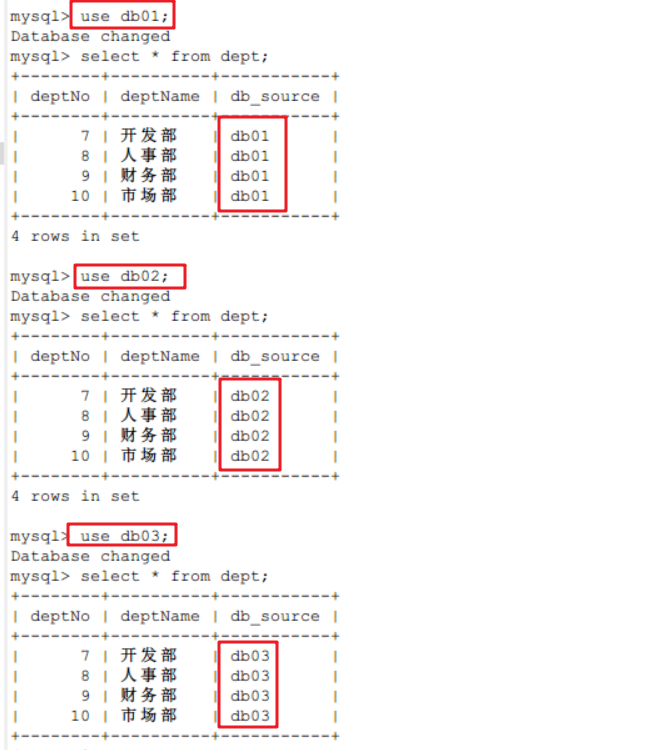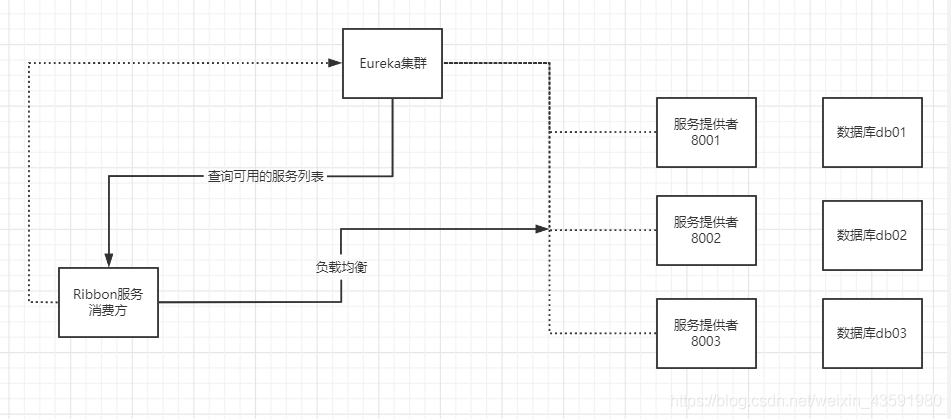一. 负载均衡以及Ribbon
1. Ribbon是什么?
- Spring Cloud Ribbon 是基于Netflix Ribbon 实现的一套客户端负载均衡的工具。
简单的说,Ribbon 是 Netflix 发布的开源项目,主要功能是提供客户端的软件负载均衡算法,将 Netflix 的中间层服务连接在一起。Ribbon 的客户端组件提供一系列完整的配置项,如:连接超时、重试等。简单的说,就是在配置文件中列出 LoadBalancer (简称LB:负载均衡) 后面所有的及其,Ribbon 会自动的帮助你基于某种规则 (如简单轮询,随机连接等等) 去连接这些机器。我们也容易使用 Ribbon 实现自定义的负载均衡算法!
2. Ribbon能干嘛?
- LB,即负载均衡 (LoadBalancer) ,在微服务或分布式集群中经常用的一种应用。
- 负载均衡简单的说就是将用户的请求平摊的分配到多个服务上,从而达到系统的HA (高用)。
- 常见的负载均衡软件有 Nginx、Lvs 等等。
- Dubbo、SpringCloud 中均给我们提供了负载均衡,SpringCloud 的负载均衡算法可以自定义。
3. 负载均衡简单分类:
- 集中式LB
即在服务的提供方和消费方之间使用独立的LB设施,如Nginx,由该设施负责把访问请求通过某种策略转发至服务的提供方! - 进程式LB
将LB逻辑集成到消费方,消费方从服务注册中心获知有哪些地址可用,然后自己再从这些地址中选出一个合适的服务器。
Ribbon 就属于进程内LB,它只是一个类库,集成于消费方进程,消费方通过它来获取到服务提供方的地址!
二. 集成Ribbon
-
导入依赖
<!--Ribbon--> <!-- https://mvnrepository.com/artifact/org.springframework.cloud/spring-cloud-starter-ribbon --> <dependency> <groupId>org.springframework.cloud</groupId> <artifactId>spring-cloud-starter-ribbon</artifactId> <version>1.4.7.RELEASE</version> </dependency> <!--Eureka--> <!-- https://mvnrepository.com/artifact/org.springframework.cloud/spring-cloud-starter-eureka --> <dependency> <groupId>org.springframework.cloud</groupId> <artifactId>spring-cloud-starter-eureka</artifactId> <version>1.4.7.RELEASE</version> </dependency> -
application.yml
server: port: 80 # Eureka配置 eureka: client: register-with-eureka: false # 不向Eureka注册自己 service-url: defaultZone: http://eureka7001.com:7001/eureka/,http://eureka7002.com:7002/eureka/,http://eureka7003.com:7003/eureka/ -
在客户端主程序中添加相关注解
@SpringBootApplication @EnableEurekaClient public class DeptConsumer_80 { public static void main(String[] args) { SpringApplication.run(DeptConsumer_80.class, args); } } -
在客户端的RestTemplate实现中添加负载均衡的注解
@Configuration // @Configuration --> spring applicationContext.xml public class ConfigBean { // 配置负载均衡实现RestTemplate @Bean @LoadBalanced //Rabbin基于客户端实现 public RestTemplate getRestTemplate(){ return new RestTemplate(); } } -
修改DeptConsumerController
因为服务访问的路径会动态变化, 所以需要修改DeptConsumerController中指定的路径
@Autowired private RestTemplate restTemplate; /** * 通过Rabbin实现的时候, 这里的地址应该是一个变量 * 应该通过服务名来访问 */ // private static final String REST_URL_PREFIX = "http://localhost:8001"; private static final String REST_URL_PREFIX = "http://SPRINGCLOUD-PROVIDER-DEPT";
三. 使用Ribbon实现负载均衡
1. 架构图
2. 具体步骤
-
创建多个服务端

-
修改每个服务的配置文件
# 指定服务的端口号 server: port: 8003 # mybatis的配置 mybatis: type-aliases-package: com.hjf.pojo config-location: classpath:mybatis/mybatis-config.xml mapper-locations: classpath:mybatis/mapper/*.xml spring: application: # 不同客户端的服务名称保持一致, 因为是通过服务名称来访问 name: springcloud-provider-dept datasource: type: com.alibaba.druid.pool.DruidDataSource driver-class-name: com.mysql.jdbc.Driver # 每个服务填自己相关的数据库 url: jdbc:mysql://jiangfengtime.top:3306/db03?useUnicode=true&characterEncoding=utf-8 username: root password: 123456 # eureka配置 # 1. 服务注册到哪里 eureka: client: service-url: # 单机发布 # defaultZone: http://localhost:7001/eureka/ # 集群发布 defaultZone: http://eureka7001.com:7001/eureka/,http://eureka7002.com:7002/eureka/,http://eureka7003.com:7003/eureka/ instance: # 修改eureka上默认描述信息 # 每个服务的注册信息 instance-id: springcloud-provider-dept8003 # info配置(顶级) info: app.name: hjf-springcloud company.name: www.jiangfengtime.top -
创建对应的数据表

-
启动服务, 查看eureka集群信息

-
查询数据信息
刷新连接, 会读取不同数据库中的数据
默认是轮询


3. 自定义切换方法
1. 调用系统自带的方法
- 案例
@Configuration // @Configuration --> spring applicationContext.xml public class ConfigBean { /** * 配置负载均衡实现RestTemplate * IRule类 * RoundRobinRule: 轮询(默认) * RandomRule: 随机 * AvailabilityFilteringRule: 先会过滤掉, 跳闸, 访问故障的服务, 对剩下的进行轮询 * RetryRule: 会先按照轮询获取服务, 如果服务获取失败, 则会在指定的时间内, 进行重试 */ @Bean @LoadBalanced //Rabbin基于客户端实现 public RestTemplate getRestTemplate(){ return new RestTemplate(); } // 轮询 @Bean public IRule myRule(){ return new RandomRule(); } }
2. 将自定义方法分离到单独的类中
-
自定义负载均衡算法类
将1中的方法拆出到单独的自定义类中
// 自定义轮询类 @Configuration public class HjfRule { // 轮询 @Bean public IRule myRule(){ return new RandomRule(); } } -
主函数中引入负载均衡算法类
@SpringBootApplication @EnableEurekaClient // 引入自定义的负载均衡算法类 // 在微服务启动的时候, 就可加载我们自定义的Ribbon类 @RibbonClient(name = "SPRINGCLOUD-PROVIDER-DEPT", configuration = HjfRule.class) public class DeptConsumer_80 { public static void main(String[] args) { SpringApplication.run(DeptConsumer_80.class, args); } } -
注意:
自定义类不能声明在主函数的统计目录之下, 因为在主函数目录之下的bean会被自动扫描加载
该包不要和主启动类所在的包同级,要跟启动类所在包同级

-
自定义类
public class HjfRandomRule extends AbstractLoadBalancerRule { private int total = 0; // 被访问的次数 private int currentIndex = 0; // 当前是谁在提供服务 public Server choose(ILoadBalancer lb, Object key) { if (lb == null) { return null; } Server server = null; while (server == null) { if (Thread.interrupted()) { return null; } // 获取活着的服务 List<Server> upList = lb.getReachableServers(); // 获取全部的服务 List<Server> allList = lb.getAllServers(); int serverCount = allList.size(); if (serverCount == 0) { return null; } // ****************自定义方法**************************** if (total < 5) { server = upList.get(currentIndex); total += 1; } else { total = 0; currentIndex += 1; if (currentIndex >= upList.size()){ currentIndex = 0; } // 从或者的服务中, 获取指定的服务来操作 server = upList.get(currentIndex); } // ******************************************** if (server == null) { Thread.yield(); continue; } if (server.isAlive()) { return (server); } server = null; Thread.yield(); } return server; } @Override public Server choose(Object key) { return choose(getLoadBalancer(), key); } @Override public void initWithNiwsConfig(IClientConfig clientConfig) { // TODO Auto-generated method stub } }
最后
以上就是美丽摩托最近收集整理的关于Spring Cloud学习笔记——06Ribbon:负载均衡(基于客户端)的全部内容,更多相关Spring内容请搜索靠谱客的其他文章。
本图文内容来源于网友提供,作为学习参考使用,或来自网络收集整理,版权属于原作者所有。




![java nginx 502_[运维] 请求 nginx 出现 502 Bad Gateway 的解决方案!](https://file2.kaopuke.com:8081/files_image/reation/bcimg8.png)




发表评论 取消回复